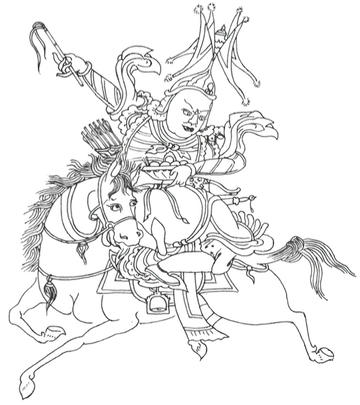The Rhinoceros Book: Account of the Divine Rlang Clan
Rlangs kyi po ti bse ru rgyas pa
Introduction
This is the mythical genealogy of the Lang Pakmodru (rLangs Phag mo gru), who originated in eastern Tibet and rose to a position of political power in central Tibet in the fourteenth century. The basic genealogy is probably of ancient origin and was redacted in the form known today when the Pakmodru acquired their power. The text contains an account of the names and lives of the members of this extended family, including heroes and religious figures. One of the most important of these is Jangchub Drékol (Byang chub ’dre bkol), who is said to have lived in around the eleventh century, and who meets Ling Gesar, in eastern Tibet. Fitzherbert (2018) suggests that the political function of this story was to augment the charisma and authority of the Pakmodru and give them authoritative status over the Gesar-orientated clans and principalities of eastern Tibet.
Download this resource as a PDF:

Sketch depicting the mountain deity Rma chen spom ra. Rma chen spom ra was the dgra lha of the Lha gzigs clan.
Sources
Lha rigs rlangs kyi rnam thar: a detailed account of the rLangs lineage of Phag-mo-gru-pa rulers of Tibet, incorporating versions of the ‘rLangs Po ti bse ru’ and the ‘Si tu bka’ chems’ of Si-tu Byang-chub-rgyal-mtshan, reproduced from a copy of an original manuscript in the library of Tsepon W.D. Shakabpa by T. Tsepal Taikhang. 1974. New Delhi, fols 2–212. BDRC: W1KG9562
Rlangs kyi gdung rgyud Po ti bse ru. 1978. In The history of the gNyos lineage of Kha rag and a version of the rLangs po ti bse ru containing the genealogy of the rLang lineage. Dolanji: Khedup Gyatso, fols 97–337. [Kept at the LTWA in Dharamsala]
lHa gzigs rLangs kyi gdungs rabs po ti bse ru bzhugs. 1982. Lhasa: Bod ljongs spyi tshogs tshan rig khang.
Lha rigs rLangs kyi skye rgyud and rLangs kyi po ti bse ru che dge yig tshang dang mi rgyud grol thabs. In Rlangs kyi po ti bse ru rgyas pa. 1986. Chab spel Tshe brtan phun tshogs (ed.) Lhasa: Bod ljongs mi dmangs dpe skrun khang, 1–99. BDRC: W18579
An edition consulted by Stein is kept by the descendants of gDan sa pa in Sikkim. Another, western style book, to which he refers was photo-copied or micro-filmed by Japanese scholars, and is available in the Toyo Bunko library. We are grateful for Reinier Langelaar for his notes on the different editions.
References
Stein, R. A. 1962. Une source ancienne pour l’histoire de l’épopée tibétaine: le rlangs Po-ti bse-ru, Journal Asiatique 250: 77–106.
Czaja, Olaf. 2013. Medieval Rule in Tibet: The Rlang Clan and the Political and Religious History of the Ruling House of Phag mo gru pa. Vienna: Verlag der Österreichischen Akademie der Wissenschaften.
Fitzherbert, George. 2018. Law and the Gesar Epic. In F. Pirie (ed.) Law and Buddhism: Practice and Principle in Historic Tibet, special issue of the Cahiers d’Extrême Asie.
In the 1986 edition, the Potiseru is followed by the Testament of Jangchub Gyaltsen, to whom the authorship of the Potiseru is also ascribed.
Outline and extracts
The page references are to the 1986 edition. However, this is known not to be not the most reliable edition and others should be consulted, where possible.
The text begins with an account of the mythical origins of the rLangs, which, as Czaja (2013: 31) points out, resembles Bon histories. There follow complicated lists of names and relations, which include a line of heroes (dpa’ bo), a number of wealthy individuals, and a line of mahāsiddhas. One of the most important of these is Jangchub Drékol, who claims to be an incarnation of Padmasambhava. He finds the Potiseru after receiving a prophecy.
In an early section of the long account of his life, the sage sets off for China in search of his destined disciples. In eastern Tibet, he meets Ling Gesar, who gives the sage various gifts and takes him as his lama, whereupon the sage is given safe passage by all the local deities of the region, headed by Pomra (Rma rgyal spom ra), the great mountain god of north eastern Tibet. The sage then arrives safely at the Five-Peaked Mountain (五臺山Wǔtái shān) in China, where he immerses himself in religious retreat. After some time, Gesar appears there, apparently on a horse-trading mission in China. He asks Jangchub Drékol to return to Tibet and offers the sage a variety of gifts:
[p. 46]
ཁྱེད་གདན་འདྲེན་པ་ལ་ཡོང་བས། གྲུབ་པ་ཐོབ་པའི་རྣལ་འབྱོར་པ། བོད་ཀྱི་ཡུལ་དུ་འབྱོན་པར་ཞུ། བདག་ལ་ཁྲིམས་ཀྱི་དངུལ་མདུང་ཀེ་རུ་དང་། ཁྲིམས་ཀྱི་རྔ་བོ་ཆེ་ཟིལ་གནོན་དང་། ཁྲིམས་དར་ནག་པོ་ཟིལ་གནོན་དང་། རྒྱ་ནོར་བསམ་གྱིས་མི་ཁྱབ་པ་འབུལ་རྒྱུ་ཡོད་ཟེར་ནས་ཞུས
I have come to meet you, spiritual practitioner, to request that you come to Tibet. I am offering you the silver spear of the law [called] Ke ru, the great drum of the law [called] the vanquisher (zil gnon), the black banner of the law [called] the vanquisher, and inconceivable amounts of wealth.
These are mentioned again on p. 48, where the banner is called dgra ’dul, the subduer.
Towards the end of his life, when he has lived for 108 years, Jangchub Drékol gives a prophecy that in thirteen generations the Lang clan will rule over Tibet (Bod khams). He then distributes his treasures among his nephews:
[p. 75]
ཁྲིམས་ཀྱི་དངུལ་མདུང་ཀེ་རུ་རྣམས་དང་ཟས་ནོར་བསམ་གྱིས་མི་ཁྱབ་པ་སྟོན་བཙུན་ལ་གནང་། རྟ་འཛག་གསེར་གསུམ་རེ་ཡང་གསུམ། བརྒྱད་དངོས་ས་གསུམ། སྤུ་བོ་དངུལ་ཤོད་རྣམས་དང་ཐང་ཡིག་སྒྲོན་མ། རླངས་ཀྱི་པོ་ཏི་བསེ་རུ། ཁྲིམས་དར་ནག་པོ་དགྲ་འདུལ། དཀར་པོ་ཐོག་རྒྱུགས། ཁྲིམས་ཀྱི་རྔ་བོ་ཆེ་ཟིལ་གནོན། རལ་གྲི་འཕར་མ་ཡིས་རྒྱུས་ཆོད་རྣམས་དང། ནོར་བསམ་གྱིས་མི་ཁྱབ་པ། གཡུ་འཛིན་གསེར་གསུམ་གྱི་ཡུལ་མདོ་པ་ལ་གནང་། རྔ་གྲབ་པ་གཡུང་རྒྱལ་ལ། བེར་ནག་པོ་ཐོག་རྡུགས། དར་ནག་པོ་ཆུང་བ། གྲི་ཤང་ལང་རིང་མོ། དབང་གི་གསེར་བར། བསྟན་པ་འགྱོགས་པའི་གླང་པོ།
The silver spears of the law [called] Ke ru, and inconceivable amounts of wealth he granted to sTon btsun. … The black banner of the law [called] the subduer of enemies, the white one that strikes like lightening, the great drum of the law [called] the vanquisher, the special sword that cuts, and inconceivable amounts of wealth ... he granted to the Yul mdo pa. [To Pho nya mgo khri he granted] the rNga grab pa gyung rgyal la, the black staff that strikes like lightning, the small black banner, the long knife, the golden staff of authority, the elephants that bear the doctrine …




